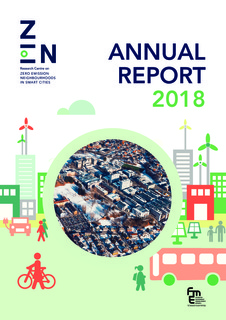| dc.description.abstract | Summary of the research from 2018
After two years of operation, the Research Centre on Zero Emission Neighbourhoods in Smart Cities (ZEN Centre) is be¬ginning to find its form. PhDs, Postdocs, and researchers are collaborating across work package boundaries, and the num¬ber of activities associated with the pilot areas is increasing. Public and industry partners are seeing more opportunities to connect their ongoing activities to the ZEN Centre. Communication and innovation strategies are in place, ensuring a strong focus on important areas for the Centre. Scientifically, important results have been completed and dissemina¬ted. A selection is presented below and in English and Norwegian in the articles that follow.
We have a definition of a zero emission neighbourhood; it is defined as a group of interconnected buildings with associ¬ated infrastructure, located within a con¬fined geographical area, aiming at reducing its direct and indirect greenhouse gas (GHG) emissions towards zero. Life cycle assessment (LCA) is used to estimate the potential environmental impacts of a product or service system throughout its life cycle. The methodology was initially developed and used for zero emission buildings. We have now expanded it to include zero emission neighbourhoods (ZENs).
Drivers and barriers to implementing ZEN concepts in Norway have been explored. Preliminary findings are that inflexible regulations and misunderstanding of the concept are important barriers. Best practice projects as well as enthusiasts in key positions are important drivers. We have also explored key drivers of success and failure regarding public private col¬laboration in a ZEN context. Five themes can contribute to successful collaborati¬on: supportive public policy, stakeholder management, a common ground for understanding, knowledge sharing and learning, and uncertainty management.
An Excel-based energy profiles generator has been developed. The tool generates aggregated energy use profiles (split in electric and thermal). The tool may be used for any given neighbourhood, based on the floor area (m2) of building types and statistically representative typical energy use profiles. The profiles are extracted from a database of well-moni¬tored buildings.
eTransport is a PC-tool for optimization of operation and developing energy systems within confined areas. Through ZEN we have re-established the program and developed two new modules: A battery module and a district heating module. A case study in collaboration with the FutureBuilt project “Microenergy system Furuset” is underway.
We are currently developing an indicator method based on the Geographical Information System (GIS), to analyse spatial conditions essential to carbon emissions in neighbourhoods. The method is being tested by analyzing specific variables re¬lated to building morphology, building densities, and spatial properties of street networks in the pilot project Sluppen in Trondheim.
Work has started in nine pilot projects: Ydalir in Elverum, Furuset in Oslo, NTNU Campus and Sluppen in Trondheim, Zero Village Bergen, Lø in Steinkjer, Nyby Bodø, Fornebu in Bærum, and Campus Evenstad in Hedmark. ZEN researchers are working with municipalities and oth¬er stakeholders to define goals and key performance indicators (KPIs). They offer advice, test and analyze solutions, and document the KPIs.
Two living labs have been organised in Evenstad and Steinkjer. Living labs reveal barriers against zero emission innovation that are often not visible before these innovations affect end-users and other stakeholders. In Steinkjer, we observed how future end-users organized political opposition to reusing a building, providing useful insight that can support start-up processes in other zero emission neighbourhoods.
The thermal performance of wood fiber and mineral-based insulation materials were studied in a laboratory experiment, investigating whether natural convection and varying moisture levels in the insulation influenced the thermal performance. Thermal conductivity was shown to be unaffected by moisture in the hy¬groscopic range. Natural convection increased the heat transmission by upto 10 percent in the 400 mm thick walls. The effect of these factors on total hea¬ting demand in two case buildings had a negligible impact.
In the research snapshots that follow, you can read more about our testing, development, design, collaboration and implementation. Much has been accom-plished, and this year’s results provide a strong foundation for working towards a low carbon society. We are on our way to making this happen! | |
